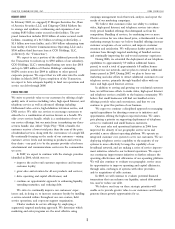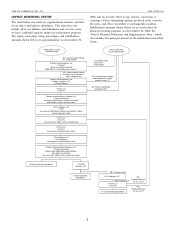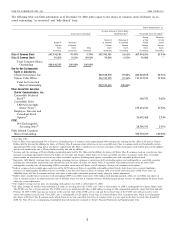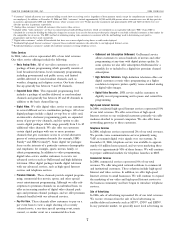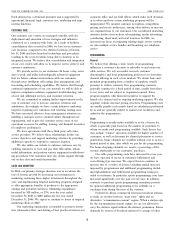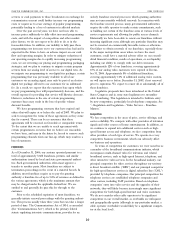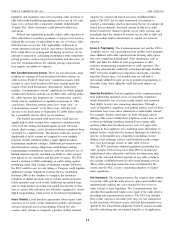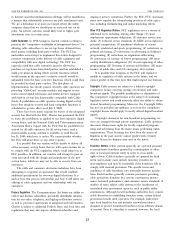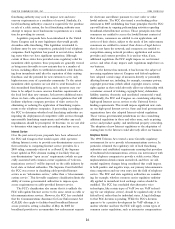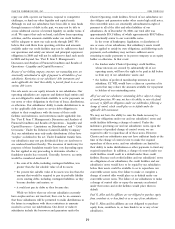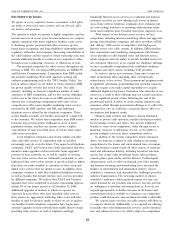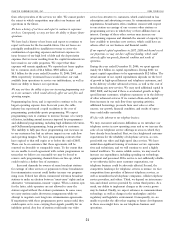Charter 2006 Annual Report Download - page 25
Download and view the complete annual report
Please find page 25 of the 2006 Charter annual report below. You can navigate through the pages in the report by either clicking on the pages listed below, or by using the keyword search tool below to find specific information within the annual report.
CHARTER COMMUNICATIONS, INC. 2006 FORM 10-K
Although cable operators tend not to be direct competitors, telecommunications carriers allow similar bundling of services in
their relative size may affect the competitive landscape in terms certain areas, and DBS providers are making investments to
of how a cable company competes against non-cable competi- offer more high definition programming, including local high
tors in the market place as well as in relationships with vendors definition programming. Competition from DBS service provid-
who deal with cable operators. For example, a larger cable ers may also present greater challenges in areas of lower
operator might have better access to and pricing for the population density, and we believe that our systems serve a
multiple types of services cable companies offer. Also, a larger higher concentration of such areas than those of other major
entity might have more advantageous access to financial cable service providers.
resources and acquisition opportunities. DBS providers have made attempts at widespread deploy-
Our key competitors include: ment of high-speed Internet access services via satellite, but
those services have been technically constrained and of limited
DBS appeal. DBS providers continue to explore options, such as
Direct broadcast satellite is a significant competitor to cable combining satellite communications with terrestrial wireless
systems. The DBS industry has grown rapidly over the last networks, to provide high-speed Internet and other services.
several years, and now serves more than 27 million subscribers DBS providers have entered into joint marketing arrangements
nationwide. DBS service allows the subscriber to receive video with telecommunications carriers allowing them to offer terres-
services directly via satellite using a dish antenna. Furthermore, trial DSL services in many markets.
EchoStar and DirecTV both have entered into joint marketing
agreements with major telecommunications companies to offer Telephone Companies and Utilities
bundled packages combining telephone, including wireless, as The competitive environment has been significantly affected by
well as high-speed Internet and video services. technological developments and regulatory changes enacted
Video compression technology and high powered satellites under the Telecommunication Act of 1996 (the ‘‘1996 Telecom
allow DBS providers to offer more than 200 digital channels Act’’), which amended the Communications Act and which is
from a single satellite, thereby surpassing the typical analog designed to enhance competition in the cable television and
cable system. In 2006, major DBS competitors offered a greater local telephone markets. Federal cross-ownership restrictions
variety of channel packages, and were especially competitive at historically limited entry by local telephone companies into the
the lower end pricing, such as a monthly price of approximately cable business. The 1996 Telecom Act modified this cross-
$35 for 60 channels compared to approximately $50 for the ownership restriction, making it possible for local exchange
closest comparable package offered by us in most of our carriers, who have considerable resources, to provide a wide
markets. In addition, while we continue to believe that the initial variety of video services competitive with services offered by
investment by a DBS customer exceeds that of a cable customer, cable systems.
the initial equipment cost for DBS has decreased substantially, Telephone companies already provide facilities for the
as the DBS providers have aggressively marketed offers to new transmission and distribution of voice and data services, includ-
customers of incentives for discounted or free equipment, ing Internet services, in competition with our existing or
installation, and multiple units. DBS providers are able to offer potential interactive services ventures and businesses. Telephone
service nationwide and are able to establish a national image companies can obtain the right to lawfully enter the cable
and branding with standardized offerings, which together with television business and some telephone companies have been
their ability to avoid franchise fees of up to 5% of revenues and extensively upgrading their networks to provide video services,
property tax, leads to greater efficiencies and lower costs in the as well as telephone and Internet access service.
lower tiers of service. However, we believe that cable-delivered Two major local telephone companies, AT&T Inc.
OnDemand and Subscription OnDemand services are superior (‘‘AT&T’’) and Verizon Communications, Inc. (‘‘Verizon’’), have
to DBS service, because cable headends can store thousands of both announced that they intend to invest in upgrading their
titles which customers can access and control independently, networks. Some upgraded portions of these networks are or will
whereas DBS technology can only make available a much be capable of carrying two-way video services that are techni-
smaller number of titles with DVR-like customer control. We cally comparable to ours, high-speed Internet services that
also believe that our higher tier services, particularly bundled operate at speeds as high as or higher than those we make
premium packages, are price-competitive with DBS packages, available to customers in these areas, and digital voice services
and that many consumers prefer our ability to economically that are similar to ours. In addition, these companies continue to
bundle video packages with high-speed Internet packages. offer their traditional telephone services, as well as bundles that
Further, cable providers have the potential in some areas to include wireless voice services provided by affiliated companies.
provide a more complete ‘‘whole house’’ communications We believe that AT&T’s and Verizon’s upgrades have been
package when combining video, high-speed Internet, and tele- completed in systems representing approximately 1% of our
phone services. We believe that this ability to bundle services homes passed as of December 31, 2006. Additional upgrades in
differentiates us from DBS competitors and could enable us to markets in which we operate are expected.
win back former customers who migrated to satellite. However, Although telephone companies have obtained franchises or
joint marketing arrangements between DBS providers and alternative authorizations in some areas and are seeking them in
11



